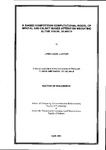A BIASED COMPETITION COMPUTATIONAL MODEL OF SPATIAL AND OBJECT-BASED ATTENTION MEDIATING ACTIVE VISUAL SEARCH
| dc.contributor.author | LANYON, LINDA JANE | |
| dc.contributor.other | Faculty of Science and Engineering | en_US |
| dc.date.accessioned | 2013-09-24T10:18:32Z | |
| dc.date.available | 2013-09-24T10:18:32Z | |
| dc.date.issued | 2005 | |
| dc.identifier | NOT AVAILABLE | en_US |
| dc.identifier.uri | http://hdl.handle.net/10026.1/1917 | |
| dc.description.abstract |
A computational cognitive neuroscience approach was used to examine processes of visual attention in the human and monkey brain. The aim of the work was to produce a biologically plausible neurodynamical model of both spatial and object-based attention that accounted for observations in monkey visual areas V4, inferior temporal cortex (IT) and the lateral intraparietal area (LIP), and was able to produce search scan path behaviour similar to that observed in humans and monkeys. Of particular interest currently in the visual attention literature is the biased competition hypothesis (Desimone & Duncan. 1995). The model presented here is the first active vision implementation of biased competition, where attcntional shifts are overt. Therefore, retinal inputs change during the scan path and this approach raised issues, such as memory for searched locations across saccades, not addressed bv previous models with static retinas. This is the first model to examine the different time courses associated with spatial and object-based effects at the cellular level. Single cell recordings in areas V4 (Luck et al., 1997; Chelazzi et al., 2001) and IT (Chelazzi ct al., 1993, 1998) were replicated such that attentional effects occurred at the appropriate time after onset of the stimulus. Object-based effects at the cellular level of the model led to systems level behaviour that replicated that observed during active visual search for orientation and colour feature conjunction targets in psychophysical investigations. This provides a valuable insight into the link between cellular and system level behaviour in natural systems. At the systems level, the simulated search process showed selectivity in its scan path that was similar to that observed in humans (Scialfa & Joffe, 1998; Williams & Reingold, 2001) and monkeys (Motter & Belky. 1998b), being guided to target coloured locations in preference to locations containing the target orientation or blank areas. A connection between the ventral and dorsal visual processing streams (Ungerleider & Mishkin. 1982) is suggested to contribute to this selectivity and priority in the featural guidance of search. Such selectivity and avoidance of blank areas has potential application in computer vision applications. Simulation of lesions within the model and comparison with patient data provided further verification of the model. Simulation of visual neglect due to parietal cortical lesion suggests that the model has the capability to provide insights into the neural correlates of the conscious perception of stimuli The biased competition approach described here provides an extendable framework within which further "bottom-up" stimulus and "top-down" mnemonic and cognitive biases can be added, in order to further examine exogenous versus endogenous factors in the capture of attention. | en_US |
| dc.language.iso | en | en_US |
| dc.publisher | University of Plymouth | en_US |
| dc.title | A BIASED COMPETITION COMPUTATIONAL MODEL OF SPATIAL AND OBJECT-BASED ATTENTION MEDIATING ACTIVE VISUAL SEARCH | en_US |
| dc.type | Thesis | |
| plymouth.version | Full version | en_US |
| dc.identifier.doi | http://dx.doi.org/10.24382/3943 |
Files in this item
This item appears in the following Collection(s)
-
01 Research Theses Main Collection
Research Theses Main


